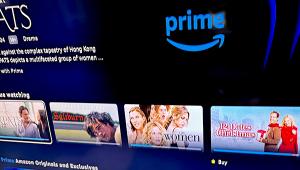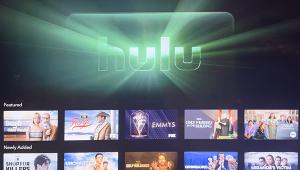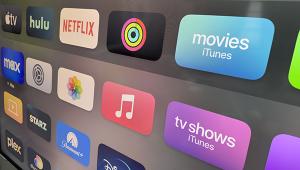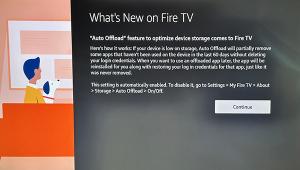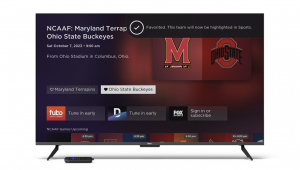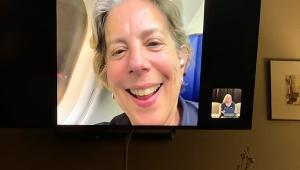Hands On: How Useful Is Voice Control with Popular Streaming Devices?

Before we start, a quick recap: Devices that support Google Home voice control include Chromecast dongles, Dish’s Hopper DVR and extension receivers, and most current Roku players, while Nvidia Shield TV and Amazon’s Fire TV support Alexa.
Nvidia Shield TV
The addition of Amazon Alexa to the Nvidia Shield was surprising since the Shield is an Android (Google) TV with a built-in Google Assistant. Nonetheless, the Shield responded well to Alexa. As with Google Assistant, Alexa can launch apps as well as rewind and fast forward in HBO, Google Play Movies and TV, Hulu, and Vudu. But when it comes to Netflix, for now Alexa can only be used for play and pause. The Alexa command to turn on the Shield also turns on any connected home theater gear and switches inputs thanks to HDMI-CEC protocol, which consolidates control of devices connected via HDMI. Other Alexa commands include controlling volume, navigating to the home screen, and viewing the battery levels of controllers. What Alexa can’t be used for at this time is
To set up Alexa with the Shield, you need to log into your Nvidia account on the Shield. It’s possible to set up a Shield using only a Google account but you have to first sign up for an Nvidia Shield account on your computer and then link the Shield to that account. After you create an account, go to Settings on the Shield, scroll down to Add Account and choose Nvidia. Then, follow the onscreen instructions, enter the supplied code to link your account to the Shield. Once the device is linked to the account, you have to go into to the Amazon Alexa app on your phone, search for the Nvidia Shield Skill and enable it.
The Nvidia shield can also be controlled via external Google Home devices and its native Google voice control capabilities — handled via the microphone built into the Shield Controller — were recently expanded to include commands for controlling volume, displaying photos from Google Photos, and starting playback of certain titles on Netflix, HBO Now, CBS, Viki, and Starz. During my testing, response to Google voice commands was excellent. When I asked Google to “show me my pictures from Nebraska on Shield,” the appropriate slideshow appeared within seconds.
Roku
Google Home devices can now also control Roku media players and Roku TVs once they are updated to the Roku 8.1 operating system. When HDMI-CEC and “Fast TV Start” are enabled on the Roku device, asking a Google Home device to “turn on my Roku” will also turn on a connected TV and AV receiver and switch to the correct input. Voice commands can also be used to launch apps and control volume as well as switch inputs on Roku TVs.
I was able to control my Roku Premiere+ with voice commands via my Google Home but encountered a few glitches. For example, when I asked Google Home to turn up the volume, it continued to rise as if I were giving additional commands. I had to pause the program I was watching to stop the volume from increasing. I was also unable to open Netflix using a verbal command. In all fairness, the Google Home implementation is still new, so I suspect these bugs will be fixed in future updates.
Dish
Dish added Amazon Alexa voice control to its Hopper DVR last year and its functionality has steadily improved over the past 18 months, allowing you to search for specific titles and genres, find shows with specific actors, and access channels by number or name. During testing, Hopper responded to most commands quickly and correctly — as long as I spoke clearly. Along with basic playback, you can rewind (in increments) and fast forward in recorded shows as well as record the show you are currently watching or one you find through search. All this is not much of a surprise, since Dish has proven to be a leader in voice control, most recently expanding its voice roster to include commands such as “Go to On Demand,” “Go to DVR,” and “Launch YouTube.”
This past summer, Dish also added Google Home control to its Hopper DVR and extension devices — Joey and Wally. To set it up, go to the Google Home App, select Add Device, and choose Dish. Then go to Settings on the Hopper and select Google Assistant and Get Code. Once you have the “activation code,” enter it in the Google Home app on your phone and choose which Dish devices you want to control. For my testing, I selected Hopper and a couple Joey extension devices but ran into a problem: the app sent commands to the Joey receivers but not the Hopper. To enable voice control of the Hopper, I had to go into the app and remove the devices I had previously selected and select only Hopper. Looks like a bug fix is in order. While I found the overall level of control with Google voice commands to be on par with Alexa, the Hopper was a little slower to respond with Google.
Getting Smarter All the Time
Google Assistant and Amazon Alexa are getting smarter all the time. Both are able to control several different media players from the same Google Home or Amazon Echo device. Once you give a command with the name of a device — “Alexa turn on Nvidia Shield,” for example — you don’t have to repeat the name of the device with subsequent commands. You can simply say, “Alexa, launch Hulu.” When I asked Alexa to play This is Us on the Shield, she replied, “Sorry I can’t do that on Nvidia Shield. I can do that on Dish or Fire TV, which would you like?”
So, back to the original question: Does the arrival of voice control in streaming media players mean true hands-free control is here? Not quite. In my testing, I found that using voice control for navigation isn’t as good as what I’m used to with Xbox via Kinect. In other words, you can’t abandon your remote control just yet. You’ll need it to choose your profile on services like Hulu or Netflix and to navigate other menu screens. You’ll also need the remote to back out of apps, exit Netflix, or start playing a program you found through search. For now, I enjoy being able to use to verbal commands to pause a show when I have to leave the room for a few minutes or when someone wants to speak to me while I’m watching TV. There’s little doubt that voice control will eventually cover all the bases but we’ll have to wait a bit longer for that time to arrive.
- Log in or register to post comments




